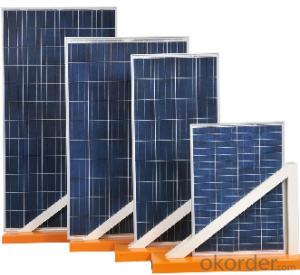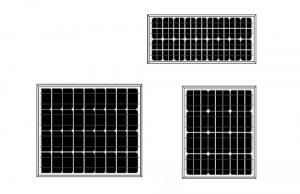High Power 250W/36V Organic Solar Panels for Sale
- Loading Port:
- Tianjin
- Payment Terms:
- TT OR LC
- Min Order Qty:
- 100 watt
- Supply Capability:
- 10000 watt/month
OKorder Service Pledge
OKorder Financial Service
You Might Also Like
Specification

Quality Ensurance:
1. Excellent A Grade solar cell from Motech or Hanwha solar.
2. Excellent backsheet from SFC, 3M;
3. EVA from Bridgestone / First;
4. Junction box with UL and TUV listed - GZX, IP65;
5. High transmission low iron tempered glass from Xinyi Glass - China Top 1;
6. Solar panels with TUV, CE, ISO9001 certified.
Strong, lightweight aluminum frame design with reinforced sealing and load hold to prevent freezing and warping, and stand against high wind.
Under Standard Test Conditions(STC): Irradiance of 1000W/m2, Am1.5 and 25º C cell temperature
Operating Temperature: -40 ~ +85° C
Storage Temperature: -40 ~ +85° C
Mechanical Characteristics:
Dimensions: 1956mm(L) x 992mm(W) x 35mm(H)
Weight: 24kg
Polycrystalline 156*156 solar cells: 72 cells
Module Warranty:
Warranty on material and workmanship: Five years
Guaranteed output of 90% after 10 years and 80% after 25 years.
| Performance | ||
| Rated Power[Pmax] | 250W | |
| Power Tolerance | ± 3% | |
| Nominal Voltage | 36V | |
| Design Life | 25 years | |
| Electrical Characteristics | ||
| Maximum Power [Pmax] | 250W± 3% | |
| Maximum Power Voltage [Vmp] | 35.56V± 3% | |
| Maximum Power Current [Imp] | 7.031A± 3% | |
| Short-Circuit Current [Isc] | 7.80A± 3% | |
| Open-Circuit Voltage [Voc] | 43.12V± 3% | |
| Current Temperature Coefficient | 0.08%/º C | |
| Voltage Temperature Coefficient | - 0.32%/º C | |
| Power Temperature Coefficient | -0.38%/º C | |
| Maximum System Voltage | 1000V | |
- Q: During the summer my house uses about .47 kw/h I am wondering what solar panel do I need to cover most or all the electric bill. A link would be helpful too :)
- Your okorder /.. A solar panel of 40-50 square meters should suffice, at least in summer when the sun is high in the sky. It's about 500 square feet, or about 20 times 25 feet.
- Q: Can solar panels be installed on a south-facing wall?
- Yes, solar panels can be installed on a south-facing wall. In fact, a south-facing wall is usually the most ideal location for solar panel installation as it receives the maximum amount of sunlight throughout the day, maximizing energy production.
- Q: i am looking at installing some solar panels and a wind turbine for electricity.has anybody got one of these and how much do they save you?thanks
- I don't have one myself, but some of my neighbors did. They said that wind is cost effective. The equipment will make money over the lifetime of the equipment. When they did the calculations for solar, the savings did not cover the cost of the equipment over its lifetime. They were very happy with their wind turbine and several months even got paid by the power company for putting energy back into the grid. However, this was when I lived in Kansas. Wind does matter on location.
- Q: I want to get a solar panel to run a fan (or two) for swamp coolers.I'm not looking to power 20box fans, just maybe some of those auto fans.What the heck kind of panel do I need? What is a power inverter and what does it do?Will I lose all my power if I use a 00' extension cord?How do I choose what I'm going to need?
- Here is one that can work for a small swamp cooler, but if you want to build a larger one, use multiple fans. This model uses .4 amps at 2 volts DC. 2 X .4 = 5 watts. You'll want about 6 watts per fan for the panel, so if you had 4 of these fans, at 5 watts each, look for a 25 watt or so sized panel. The panel should have a Volts Open Circuit (Voc) rating around 8 volts, that is normal for a 2 volt system. Then you can just wire the fans, in parallel to each other, to the output of the panel. I read an article in Home Power Magazine about a guy who did this to ventilate his crawl space. He only wanted the fans to run when it was dry weather outside, like when it's sunny. The panel not only powered the fans, but were perfect for sensing when it was sunny. You can do the same thing with the swamp cooler. This fan was clipped from Marlin Jones website, they sell small electronics and such, the link is below. They do not sell solar panels, but I've found OKorder to be a great source for them. We have two small arrays here that run LED lights in parts of our home, and charge cell phones, ipods and small electronics. Take care Jorge, Rudydoo
- Q: How do solar panels affect the property's community engagement?
- Solar panels can positively impact a property's community engagement by showcasing the owner's commitment to renewable energy and environmental sustainability. This can inspire and engage community members to consider renewable energy options themselves. Additionally, solar panels can serve as an educational tool, promoting awareness and understanding of the benefits of solar energy within the community.
- Q: My family has been interested in solar technology for a long time. I want to know how to save money so I can get as many solar panels as possible. I know the government has different discounts/ grants, and there may be tax incentives. I am not looking to sell energy to the energy company I want to use the energy directly.
- Depending okorder /
- Q: I was trying to look online for solar panels for my home to take some of the strain off of using oil and electricity but I find it very hard to understand exactly how they are used.Like one that I looked up is 00 watts.....is that like a light bulb watt? How many things can that power? Is it really cheaper in the long run because the panels are very expensive?If anyone has web sites that can explain this to me I would appreciate a link, or anyone to answer part of my question.
- Solar panels produce low voltage direct current electricity. To be used in a home that electricity must be stored in batteries and converted to 20-240 volts 60 hertz AC (alternating current). And its frequency must be synchronized to the electricity supplied by the power company. A 00 watt solar panel produces 00 watts of power, enough to power one 00 watt light bulb. To generate enough power to power a home, the solar panel must be capable of producing at least 500 to 2000 watts per hour (.5/2.0 KW/hrs) And you're quite correct, it's an expensive proposition to install a solar panel system... and it should be installed by experts.
- Q: How do solar panels affect the property's energy management strategy?
- Solar panels can significantly impact a property's energy management strategy by providing a renewable and sustainable source of electricity. By harnessing solar energy, the property can reduce its dependence on traditional power sources, lower energy costs, and decrease its carbon footprint. Solar panels can also help to stabilize energy prices, as they generate electricity during peak demand periods, reducing the need to purchase electricity from the grid. Additionally, solar panels can provide a reliable source of backup power during grid outages, enhancing the property's energy resilience. Overall, solar panels offer numerous advantages to a property's energy management strategy, promoting sustainability, cost savings, and energy independence.
- Q: Can solar panels be installed on waste treatment plants?
- Yes, solar panels can be installed on waste treatment plants. In fact, waste treatment plants provide ample space and suitable infrastructure for the installation of solar panels. This can help offset the electricity consumption of the plant and reduce its carbon footprint, making it a sustainable and environmentally friendly option. Additionally, solar panels can contribute to cost savings by generating clean energy on-site.
- Q: The intensity of sunlight at the distance of the Earth's orbit is 380 W/m2. An Earth-orbiting satellite has a solar panel that measures .35 m by 4.86 m, which converts solar energy to electrical energy with an efficiency of 26%. In one hour, how much electrical energy does the panel produce? Assume that the satellite's attitude control jets keep the panel oriented perpendicular to the incoming sunlight.
- This is pretty much an exercise in knowing units and dimensional analysis. Watts are in Joules/second. So every second a square with the area(meters^2) of meter^2 receives 380 joules from the sun. In your case the square is the solar panel. So find the area of the solar panel in m^2. If you multiply area times intensity you can see that the meters cancel out and you are left with Watts(J/s). Since you want the Joules received in an hour you again multiply by how many seconds are in an hour. Leaving you with joules. What you have now is the total energy, but your solar panel is only 26% efficient, so just multiply by .26 and you will have your energy.
Send your message to us
High Power 250W/36V Organic Solar Panels for Sale
- Loading Port:
- Tianjin
- Payment Terms:
- TT OR LC
- Min Order Qty:
- 100 watt
- Supply Capability:
- 10000 watt/month
OKorder Service Pledge
OKorder Financial Service
Similar products
Hot products
Hot Searches
Related keywords






























